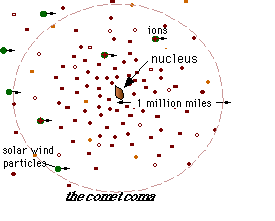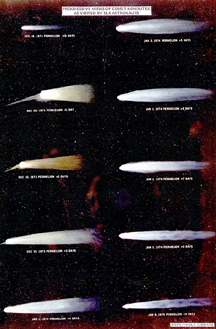Today scientists are still very interested in studying comets. These are drawings of the Comet Kohoutek based on a description by Skylab-4 astronaut Edward Gibson.
Click on image for full size
NASA
Comets Throughout History
"Threatening the world with Famine, Plague and War: To Princes, Death! To Kingdoms, many Crosses; To all Estates, inevitable Losses! To Herdsmen, Rot; to Plowmen, hapless Seasons; To Sailors, Storms, To Cities, Civil Treasons!"
De cometis by John Gadbury, London, 1665
Civilizations throughout recorded history have been fascinated with
comets, and have held them in awe, fear, and wonder. The earliest
references to comets refer to them as "terrible balls of fire" that sowed
terror. As the centuries passed, people began to see comets less as
potentially destructive objects and more as omens of either good or bad
things that would soon happen. For instance, Augustus Caesar became
emperor of Rome around the same time a comet appeared in the sky, and this
was widely held as a sign that his reign would be blessed by the gods.
Even though comets were long thought to have supernatural roles,
scientists and philosophers tried to understand what comets were and where
they came from. The Greek philosopher Aristotle thought that comets were
merely meteors, while the much later French thinking Descartes thought they
were messengers from other worlds. Still another philosopher,
Georges-Louis Buffon, thought that comets were the source of the Sun's
energy, and that they had actually set the planets in their orbits around
the Sun. Gradually, though, scientists began to see that comets appear and
disappear with regular cycles, and that they are actually small balls of
ice and dust trailed by a tail of gas and dust.
You might also be interested in:

For thousands of years, the Egyptian civilization used a written language called hieroglyphics. You may have seen this language before. It uses a lot of pictures to get a point across. When people started
...more
Comet Hale-Bopp was one of the brightest comets of all time. Astronomers witnessed the comet spew out intermittent bursts of dust. The surface seemed to be an incredibly dynamic place, with 'vents' being
...more
Six spacecraft flew to Halley's comet in 1986. There were two spacecraft launched from Japan, named Suisei and Sakigake, and two from the Soviet Union, named Vega 1 & 2. One spacecraft, ICE, was from the
...more
Astronomers have noticed a group of comets which they call the Jupiter Family of Comets. This family of comets is to be found circling between Jupiter and the sun, as shown in this picture. The comets
...more
Scientists have learned a great deal from the crash of comet Shoemaker-Levy 9. Scientists traced the orbit of the comet backwards in time to guess its origin. The crash of a comet like Shoemaker-Levy 9
...more
Mathematical theory suggests that comet Shoemaker-Levy 9 was likely a short-period comet which was captured into orbit around Jupiter in 1929. This orbit ended with a collision of the comet with Jupiter
...more
As the ices of the comet nucleus evaporate, they expand into a large cloud around the middle part of the comet. This cloud, called the coma, is the atmosphere of the comet. It can extend for millions of
...more















